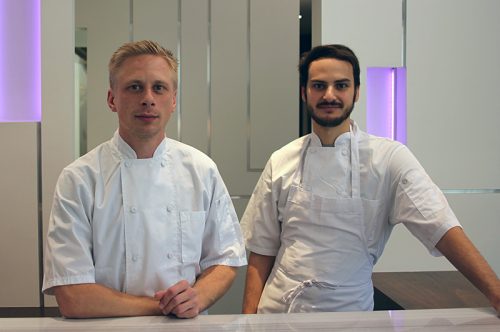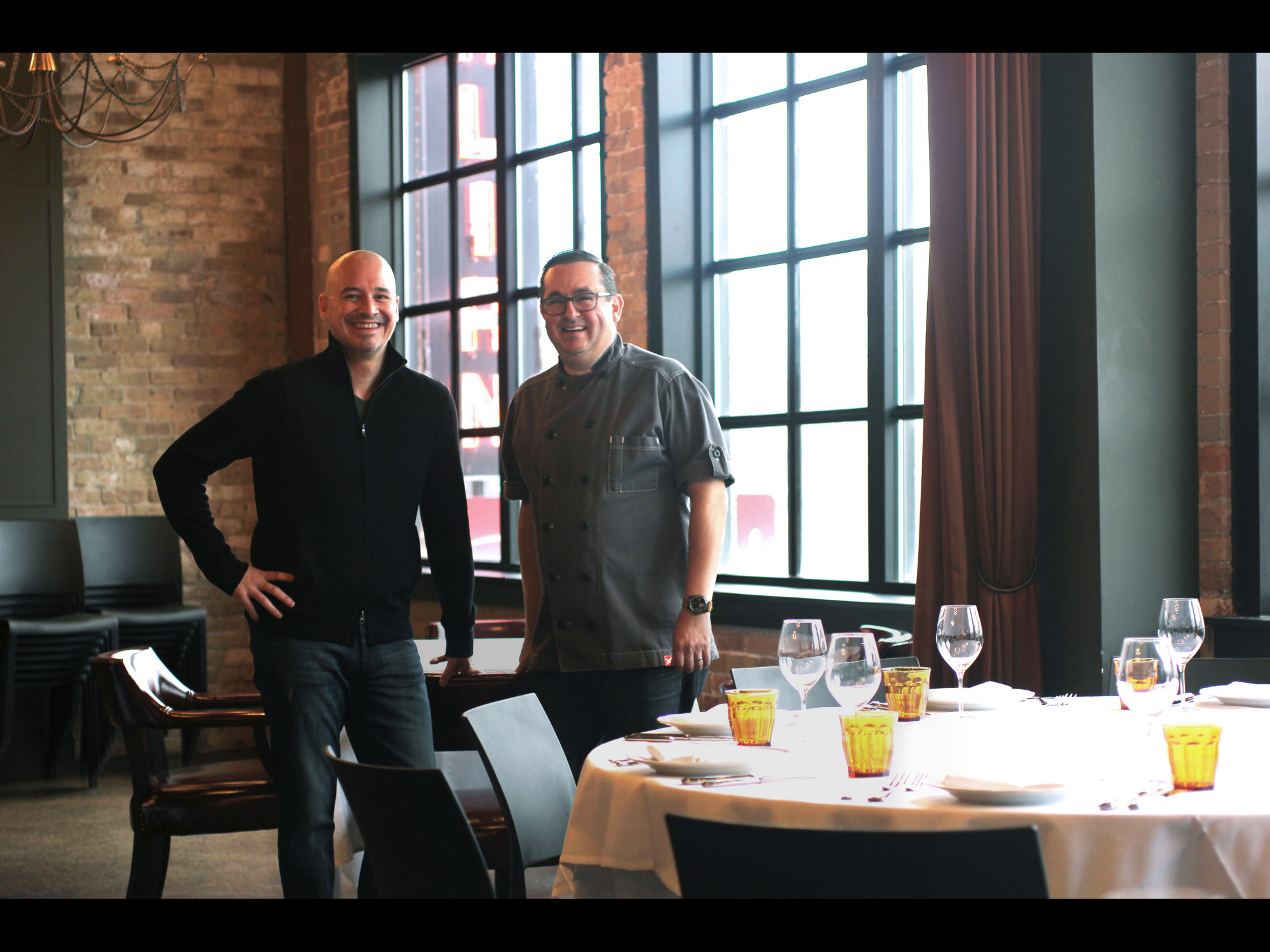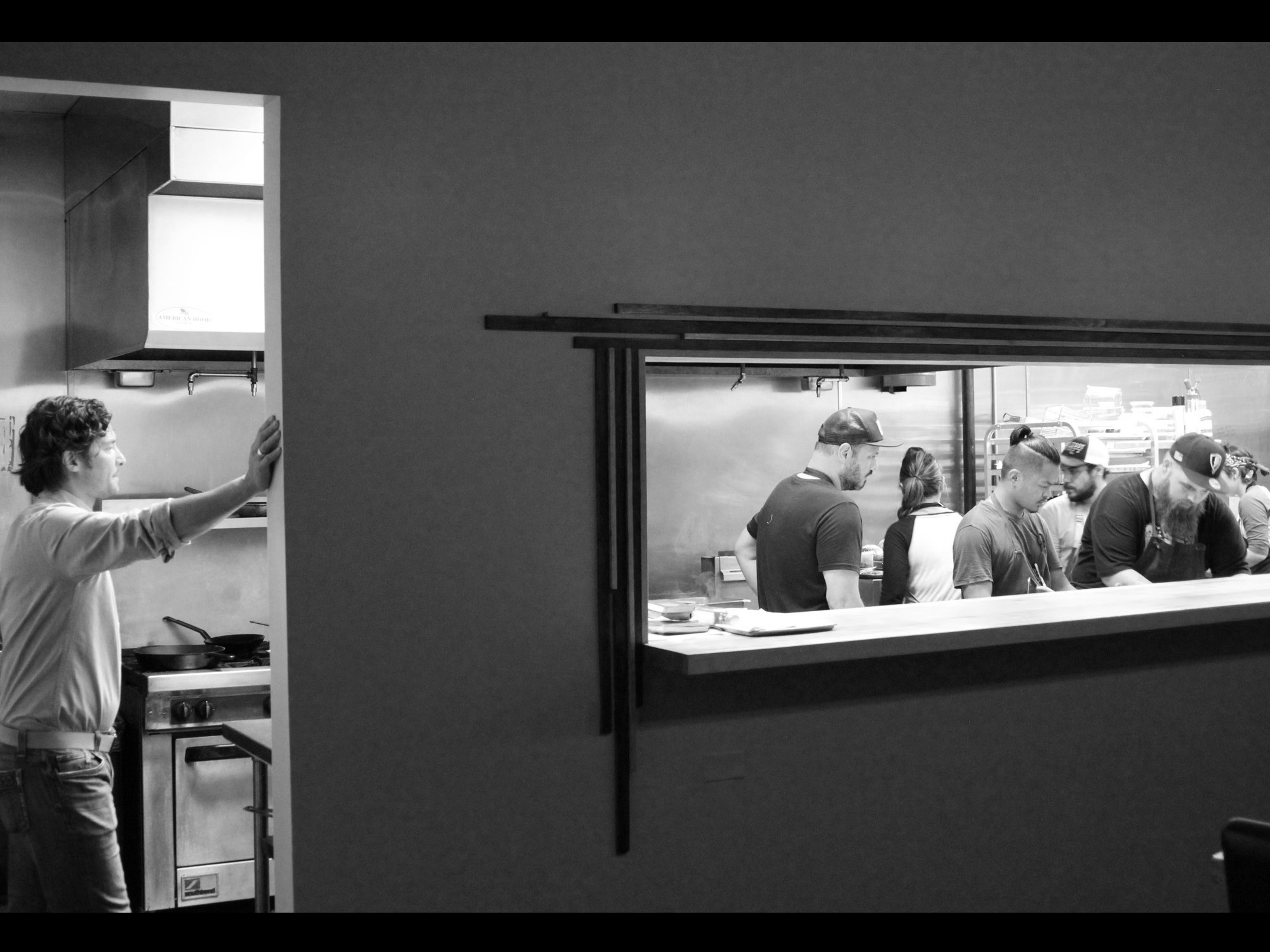THE CHEFS BEHIND TEMPORIS, A TINY TASTING MENU restaurant in West Town (it’s a block north of Ruxbin), still have hopes that they might serve a few meals in 2016, pending the city inspectors’ final okay. But it seems safe to say that even if they do, it will be seen as one of the notable openings of early next year, maybe beating the usual post-holiday slump for the restaurant business through the sheer novelty of being the newest thing.
Well, that, and the fact that it doesn’t take many bookings to fill up a restaurant with only twenty seats. This is definitely going to be an intimate, handcrafted restaurant.
Sam Plotnick and Evan Fullerton had worked together at Les Nomades, the fine dining restaurant that has a storied reputation (but seems almost completely beyond the experiences of Chicago food writers). Plotnick was also doing pop-up dinners in his apartment with another chef friend, and he began to think—”Could we recreate this environment, and these dinners, in a restaurant? And what would be kind of the simplest form of a restaurant we could do, that could make this happen? Instead of doing an 80-seat restaurant, we could do twenty seats.”
“And not lose that personal feel of going into someone’s own dining room,” says Fullerton.
By the time of the popups, Fullerton had moved on (to a restaurant called 1913 in suburban Roselle), and one day Plotnick called him up. One thing to understand—at least one publication already had to correct this—is that Plotnick used to work for Fullerton at Les Nomades, line cook and sous chef, but now Plotnick owns the restaurant and Fullerton works for him. Yet Plotnick doesn’t look at it that way, exactly.
“We talked, and we decided to go into business together and make a restaurant,” Plotnick says. “The project might have come from my vision, but in the kitchen it’s us. I wanted the creative process, and making the restaurant, to have more of the feel of a writer’s room. I think there’s something a little bit antiquated about the current way people operate restaurants—which is that there’s the one guy and he yells at you, and everyone else falls in line.”
“I’m not nearly experienced enough to want to be yelling at everyone else,” Plotnick says. “I want to bring in the best talent I can find. And Evan is the guy I wanted to bring on board so we could make the best food that we could make. Because he’s got a lot of great experience, and I’ve been lucky enough to bring a lot of good people on board.”

Chefs Evan Fullerton and Sam Plotnick
I ASK HIM WHO HE BROUGHT ON BOARD and I expect to hear about a pastry chef or a wine guy. Instead it starts, interestingly, with the architects and a lighting guy. It turns out that that’s central to the feel of Temporis—not just the physical layout, which is slightly space lounge-y, but the lighting. “It’s all LED, completely color controlled and temperature controlled,” Plotnick says. “The lights are all individually controlled for each table. We sort of have this idea that when you sit down, the lighting’s different than it’s going to be at the end of the meal. A lot of places just hit the dimmer, but we can bring in more subtle changes, more gradual changes, finish the dinner with a warm amber color.”
This brings us to the name, Temporis—which means time, or as they put it, the passage of time. Part of that, not surprisingly, is seasonality, another thing the lighting can enhance—”There’s not much nature around here, but I think the atmosphere of the restaurant can reflect it,” Plotnick says. He lifts a wooden panel out of the center of the table to reveal a small well. “We have a garden in the basement, so you could have the herbs that are used in a dish growing right here. Or we had the idea of putting a little zen garden with hot rocks, and then someone could come by with little pieces of meat or raw fish and quickly sear it on the rocks.”
We always think, what on this dish is going to make someone crave it, and want to come back.
“I like that it’s reserved,” he adds, referring to the well. “I don’t always like the idea of bringing, you know, a giant piece of driftwood to the table” as a serving piece.
It’s always hard to get someone to describe the food at the restaurant they haven’t opened yet—you can’t help but use the same words, like “seasonal”—but I ask them to contrast what they plan to do with their previous employer, Les Nomades. “Well, for one thing, it’s not going to be French, it’s going to be contemporary American, using local ingredients and any techniques we want,” Plotnick says.
“Our model is a hyperlocal menu, and then focusing it to the beginning, middle and end of a season, so we can create a full ten-course tasting menu, and we won’t change all the courses over at the beginning of a season,” Fullerton says. “Because that’s a huge undertaking for the kitchen, and also there are spring vegetables that may not be ready yet at the beginning of spring. Instead, with the passage of time—temporis—as things slowly come into season, and things slowly go out, we can replace those dishes.”
“Once you separate from the a la carte menu and do an eight-course tasting, a ten-course tasting menu, it allows you to fulfill your creative potential,” Plotnick says. “You can focus on those dishes, you know exactly how much to prep for them each night, and it allows you to put more time into making sure those things are right.”
Gallery: A First Look at Dishes at Temporis
“I think a good example is the hamachi tartare, again, taking tartare which is traditionally French,” Fullerton says. “Then taking yuzu juice, and introducing lecithin, using a little bit of the molecular gastronomy, but that not being the focus of the dish. Asian ingredients with a combination of technical French technique and a little bit of New Age science.”
“It seems like every dish on a tasting menu has to have one thing you’ve never heard of,” Plotnick says. “We think that you’ll find that our food is a touch more precise, and familiar, and comforting. We always think, what on this dish is going to make someone crave it, and want to come back. We do whatever we can to be delicious—if we need to think out of the box we can, if something classic like consommé will make it delicious, we do that.”
AS FAR AS ADHERENCE TO LOCAL FOOD tenets goes, they’re buying from Local Foods and from the farmers markets, though Plotnick says, “I don’t have an overly strong thing where I have to support local farmers over, say, California farmers. But I spent a lot of time in Michigan, and I used to go blueberry picking at Mick Klug Farms, so I guess I identify with some local farmers.”
But there’s also a source of produce in the building—a hydroponic garden in the basement. And as they start to talk about it, even more than with the controlled lighting, I pick up hints of a more radical technological approach to dining that reminds me a little of Moto and Homaro Cantu. “There’s nothing more local than growing all of your herbs and much of your greens in your own restaurant,” Plotnick says.
“With the hydroponic garden, we can somewhat challenge the idea of what a seasonal restaurant is,” Fullerton adds. “If you grew it twenty feet from the diner, who’s to say it’s not seasonal? And you can pair it with things in season that would never go together, but somehow, it’s still seasonal.”
Maybe I raise my eyebrow a little, because Plotnick hastens to explain, “If you have the opportunity to pair a perfect summer strawberry with a perfect winter parsnip, that’s pretty cool and you kind of have to do that. If you don’t want to do that, it’s because you want to stick with the traditions and the social norms.”
Hmm, like a certain French restaurant that’s known for being one of the last to stick with the social norm of wearing a jacket at dinner? Maybe they’re a little more ready to shake things up, do a little Alinea-Moto showbiz at the table, than you get at first.
“We could have a strawberry plant that’s actually grown in the winter here,” Plotnick says, pointing to the well in the table, “growing at the table. And you pick a strawberry off and it’s one of the best ones you’ve ever had. How could you say that’s not seasonal? It’s alive, right at your table.”
Michael Gebert is the editor of Fooditor, where things grow in the basement.
Give someone the gift of good restaurants this holiday season—99 of them, in fact. Get The Fooditor 99 at Amazon and for Kindle here.
Latest
Join the Discussion
After you comment, click Post. If you're not already logged in you will be asked to log in or register with Disqus.















